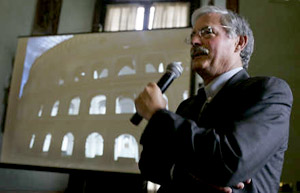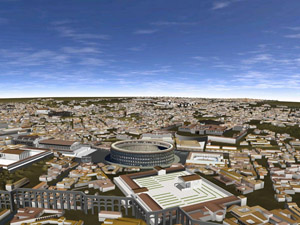IATH News
Rome Reborn: IATH Team Rebuilds Ancient Rome Digitally
Mayor of Rome Launches IATH's New Digital Model of Ancient Rome
June 11, 2007
 Bernard Frischer, director of the "Rome Reborn" project and director of the Institute for Advanced Technology in
the Humanities at the University of Virginia, stated, "Rome Reborn 1.0" is the continuation of five centuries of
research by scholars, architects and artists since the Renaissance who have attempted to restore the ruins of the
ancient city with words, maps and images. "Rome Reborn 1.0" is a true 3D model that runs in real time. Users can
navigate through the model with complete freedom, moving up, down, left and right at will. They can enter important
public buildings such as the Roman Senate House, the Colosseum, or the Temple of Venus and Rome, the ancient citys largest place of worship.
Bernard Frischer, director of the "Rome Reborn" project and director of the Institute for Advanced Technology in
the Humanities at the University of Virginia, stated, "Rome Reborn 1.0" is the continuation of five centuries of
research by scholars, architects and artists since the Renaissance who have attempted to restore the ruins of the
ancient city with words, maps and images. "Rome Reborn 1.0" is a true 3D model that runs in real time. Users can
navigate through the model with complete freedom, moving up, down, left and right at will. They can enter important
public buildings such as the Roman Senate House, the Colosseum, or the Temple of Venus and Rome, the ancient citys largest place of worship.
(June 11, 2007) Mayor Walter Veltroni presided over a press conference in Rome's city hall on the Capitoline Hill at which IATH Director Bernard Frischer, with the help of IATH staffer Kim Dylla, gave the first public viewing of a new digital model of ancient Rome. Ms. Dylla demonstrated the model with Shuttles donated to IATH by Shuttle Computer. The model shows the city as it appeared in 320 AD. Frischer was director of the project, which is called "Rome Reborn" and that has involved dozens of students and scholars from many universities in Europe and the USA. The lead 3D modeler was IATH Associate Director Dean Abernathy. The project started at UCLA in 1996 and moved to UVA in 2004. In the same year, the Politecnico di Milano became an important institutional partner in the project. The model consists of some 7,000 buildings within the late-antique Aurelian Walls. Frischer stated that "this is a major achievement in many ways. It is the largest historical simulation ever created by several orders of magnitude; it required highly innovative work by our partners at UCLA and the Politecnico di Milano; and it challenged IATH in terms of project management and creation of new facilities and resources for real-time 3D. The next big challenge is to publish the model to the web and, at the same time, to convert Rome Reborn from being the project of a closed circle of scholars to an online, peer-reviewed journal that welcomes contributions by all qualified scholars." The ultimate goal of Rome Reborn is to illustrate the entire urban evolution of Rome from the first settlement in the late Bronze Age (ca. 1000 BC) to the end of the Gothic Wars (552 AD).
The press conference was filled to standing room only and in the 48 hours following the event there was extensive media coverage in newspapers, on the Internet, and on TV.
 Image caption: Long shot of the new digital model of Rome in which many of the city's 7,000 buildings can be seen.
In the foreground is the spur of the Claudian aqueduct bringing water to the imperial palace on the Palatine Hill.
Just behind the aqueduct, in the middle, is the Temple of the Divine Claudius on the Caelian Hill.
In the middle ground, center, is the Flavian Amphitheater (also known as the Colosseum). To the right is the Ludus Magnus,
a training facility for the gladiators who fought in the nearby amphitheater, to which it was linked by a (still extant) tunnel.
To the left is the Temple of Venus and Rome, the largest temple of the state cult in the city. Next to it is seen the Basilica of
Maxentius, the last civic building constructed in the ancient city. Behind the Flavian Amphitheater is the Bath of Trajan on the Oppian Hill.
Image caption: Long shot of the new digital model of Rome in which many of the city's 7,000 buildings can be seen.
In the foreground is the spur of the Claudian aqueduct bringing water to the imperial palace on the Palatine Hill.
Just behind the aqueduct, in the middle, is the Temple of the Divine Claudius on the Caelian Hill.
In the middle ground, center, is the Flavian Amphitheater (also known as the Colosseum). To the right is the Ludus Magnus,
a training facility for the gladiators who fought in the nearby amphitheater, to which it was linked by a (still extant) tunnel.
To the left is the Temple of Venus and Rome, the largest temple of the state cult in the city. Next to it is seen the Basilica of
Maxentius, the last civic building constructed in the ancient city. Behind the Flavian Amphitheater is the Bath of Trajan on the Oppian Hill.
Copyright of The Regents of the University of California 2007. Click image to see full view.
